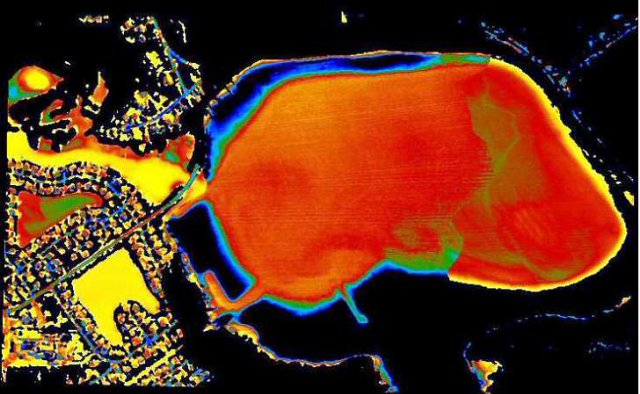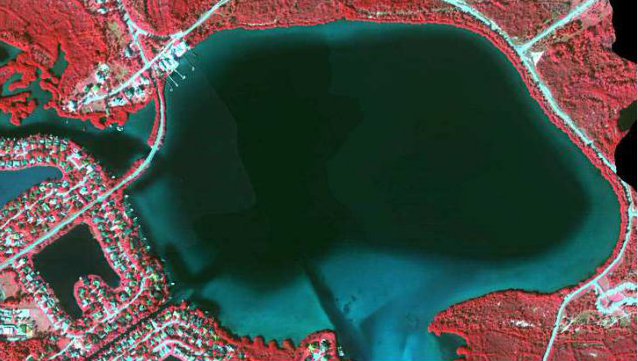 Galileo Group, Inc., announced that it has completed UAS flight operations and hyperspectral data collections for a series of missions supporting a NASA sponsored project to map sea grass beds and coral reefs in the Florida keys.
Galileo Group, Inc., announced that it has completed UAS flight operations and hyperspectral data collections for a series of missions supporting a NASA sponsored project to map sea grass beds and coral reefs in the Florida keys.
The information contained in the hyperspectral data sets is used to establish sea grass bed location, extent and its photosynthetic production, and can play a key role in monitoring changes over time relating to environmental conditions. A secondary objective was to demonstrate that UAS usage for environmental projects is feasible in light-use US airspace.
A manned sensor aircraft flown by Galileo provided concurrent hyperspectral measurements for independent cross referencing purposes. The NASA grant, known formally as “High Resolution Assessment of Carbon Dynamics in Seagrass and Coral Reef Biomes,” was awarded to the UAS Collaborative, located in Silicon Valley, which managed the overall project under the leadership of Dr. Stanley R. Herwitz as the Principal Investigator. Galileo performed the airborne collection work as contractor for the UAS Collaborative.
 Hyperspectral imaging is an advanced remote sensing technology, typically deployed from aircraft much like a mapping camera, to capture naturally occurring imaging spectra at high spatial and spectral resolution. The data sets are processed and analyzed on the ground to filter, highlight and outline specific targets of interest using advanced targeting algorithms and complex signature libraries.
Hyperspectral imaging is an advanced remote sensing technology, typically deployed from aircraft much like a mapping camera, to capture naturally occurring imaging spectra at high spatial and spectral resolution. The data sets are processed and analyzed on the ground to filter, highlight and outline specific targets of interest using advanced targeting algorithms and complex signature libraries.
For this particular project, a high resolution hyperspectral imager underwent conversion and integration by Galileo for autonomous UAS operations. This included physical engineering integration with the UAS and its control systems, and development of special autonomous software for the sensor. These tasks were accomplished on a rapid response basis with less than three months from programme start to first test flight at NASA Ames Research Center. Live science missions started shortly thereafter in Key West, FL. The converted hyperspectral sensor performed as planned, and autonomously executed all pre-programmed operations without loss of mission collection time.
Scientific analysis of the hyperspectral data will be conducted by a collaborative research team of co-principal investigators led by the UAS Collaborative: Paul Carlson, Ph.D., Florida Fish and Wildlife Research Institute; Prof. Frank Muller-Karger, Ph.D., Institute for Marine Remote Sensing, University of South Florida, College of Marine Science, St. Petersburg, FL; Prof. Chuanmin Hu, Ph.D., Optical Oceanography Laboratory, University of South Florida; Kimberly Yates, Ph.D., U.S. Geological Survey, Center for Coastal and Marine Science Center; and Deanesh Ramsewak, Institute of Marine Affairs, Trinidad and Tobago. Galileo will assist in data processing and analysis. The research findings will be published in the coming months by the investigators and additional collection flights are planned for May 2013.
“This is the first time large scale UAS-based hyperspectral data has been collected for environmental purposes in Florida,” said Dr. Zhihong Pan, Galileo Group Director of Research, who led the effort for the company. “Given the timeline requested by the customer, we had to move rapidly to integrate the sensor into the UAS nose cone, develop autonomous control software from scratch and go straight from a short NASA test certification to large scale open-water science collection. We flew five days of science collection with an aggregate deployment total of twelve hours without a single flight scrub due to the sensor system. The average mission sortie time was three hours. Over 320 gigabytes of mission data was collected over the deployment. The new autonomous control software is written so that our sensor can now be adapted for other UAS installations on a rapid response turnkey basis. It was a pleasure working with Dr. Herwitz at the UAS collaborative and the NASA mission management team led by Randall Berthold. We look forward to our continued working together in this ongoing mission series, particularly in light of the importance of the science concerning better understanding new environmental observables.”
As a supplement to its long established commercial airborne remote sensing services operations using manned aircraft, Galileo plans to continue the hyperspectral sensor UAS programme with NASA and the UAS Collaborative. Elements of the commercial programme may be expanded for environmental and research customers on an international basis, providing a turnkey collection and analysis service to demonstrate peaceful uses of UAS technology.
For purposes of advancing environmental research with hyperspectral imaging and computer processing techniques, Galileo has previously established a formal collaborative relationship with Dr. Csaba Lenart, professor of the Research Institute of Remote Sensing and Rural Development,Karoly Robert University College, Hungary. The College conducts basic and applied remote sensing research, focusing on the applications of state-of-the-art remote sensing and GIS systems and on the development of techniques to enhance the usefulness of these systems in environmental applications.
The Institute also offers a team of experienced professionals in the integration and deployment of various sensors in remote sensing through LIDAR, thermal and hyperspectral imaging technologies as well as in computer sciences (digital image processing and analysis). Working together, Galileo and the College operate as a consolidated team and perform a wide portfolio of service missions across Europe, Africa, the Middle East, Asia and the Americas.
Galileo Group, Inc. is an advanced technology company specializing in applied hyperspectral imaging. The technology was initially developed for US government applications such as detecting various ground combat targets through aerial reconnaissance. Galileo is focused on expanding its products and services using its proven hyperspectral imaging technology. The company has transitioned its imaging technology from government to commercial applications in the course of fifteen years of continuous business operations. This turnkey detection capability includes the digital extraction and analysis of spectral signatures, or “natural” bar codes, for applications such as environmental, mineral, oil and gas exploration and emerging biotechnology markets. Galileo also performs airborne LIDAR and data fusion services on a global deployment basis. In addition to its commercial work, the company regularly donates select hyperspectral data sets to science researchers and institutional educations committed to environmental research and climate change studies.
Sourcve: Press Release
